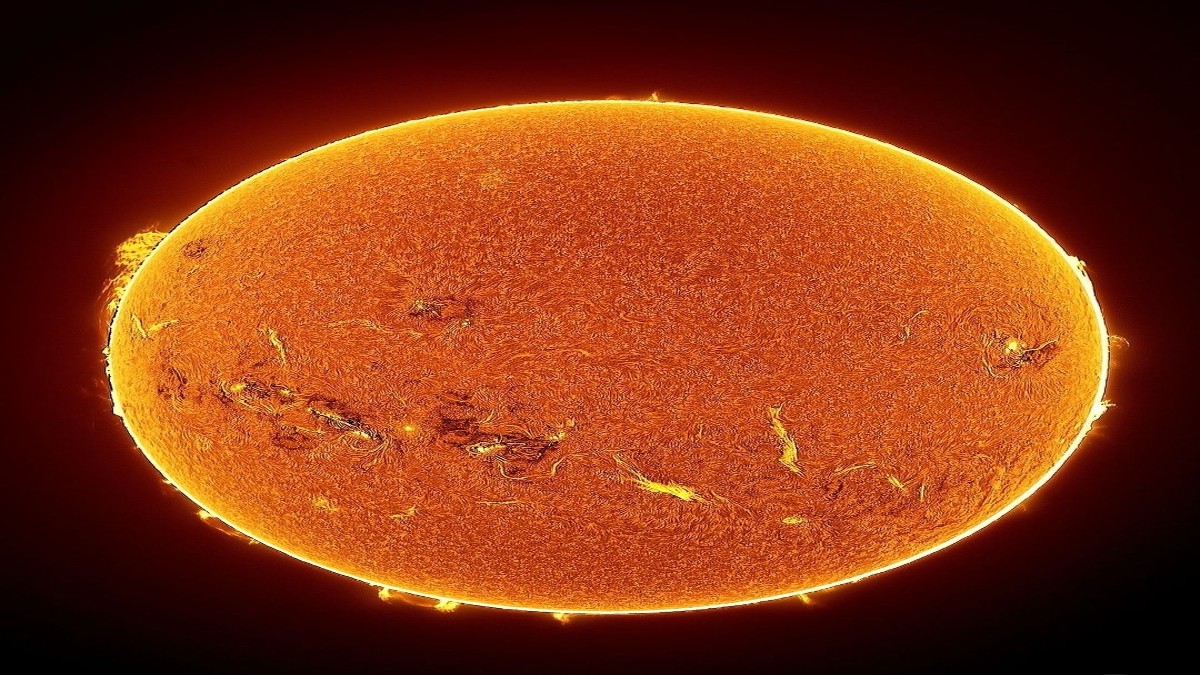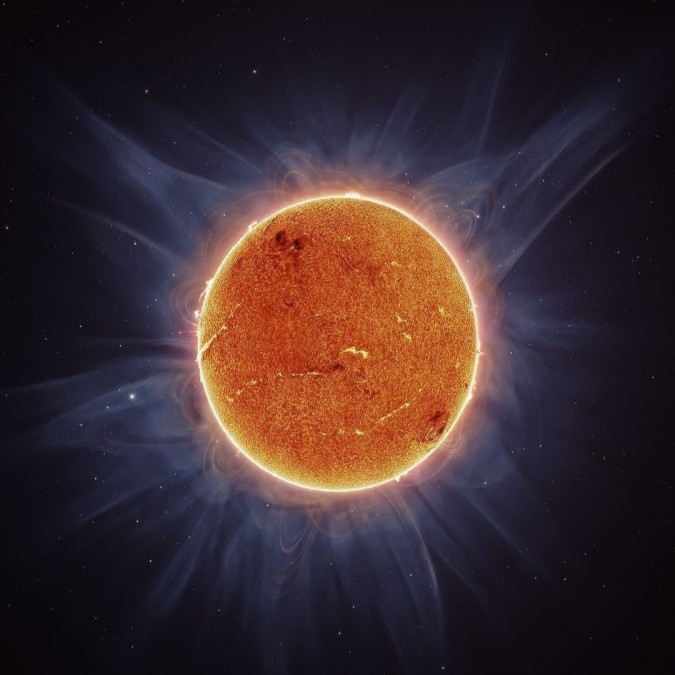
Sun
For decades, scientists and astronomers have kept a close watch on our closest star, the Sun, to understand its dynamic and cyclical nature. Every 11 years or so, the Sun goes through a natural solar cycle characterized by varying levels of solar activity. The most intense part of this cycle, known as the “solar maximum,” marks a period of heightened solar activity where sunspots, solar flares, and coronal mass ejections (CMEs) are more frequent. Recently, it has been reported that the Sun has officially entered its solar maximum. This significant event brings with it many potential effects on Earth, our technology, space exploration, and even our health.
In this article, we will explore in-depth what the solar maximum means, what its implications are, and what we can expect in the coming years as the Sun moves through this active phase.
What is the Solar Cycle?
Before diving into the solar maximum, it is essential to understand the solar cycle as a whole. The Sun’s activity ebbs and flows in roughly 11-year cycles, a period determined by the dynamics of its magnetic field. This activity is largely driven by the Sun’s magnetic field flipping – the Sun’s north and south poles switch places – which influences solar phenomena like sunspots, solar flares, and CMEs.
The solar cycle is typically divided into two phases:
- Solar Minimum: A period of lower solar activity, with fewer sunspots and less solar flare activity.
- Solar Maximum: The opposite phase, characterized by increased numbers of sunspots and more frequent solar storms.
The solar maximum is when the Sun’s magnetic field is the most unstable, leading to the release of enormous amounts of energy in the form of solar flares and CMEs. During this phase, Earth’s atmosphere and magnetic field can experience heightened impacts from the Sun’s increased activity.
Reaching Solar Maximum: How is it Measured?
The solar maximum is determined by monitoring the number of sunspots on the Sun’s surface. Sunspots are temporary dark patches that form due to intense magnetic activity in specific areas of the Sun’s surface. These spots are cooler than the surrounding areas and represent regions where magnetic energy is building up.
Scientists track the number of sunspots using satellites, ground-based observatories, and space weather monitoring systems. When sunspot numbers reach a peak, this is the hallmark of the solar maximum. The solar maximum we are currently experiencing is a part of Solar Cycle 25, which began in December 2019. After several years of increasing activity, astronomers have now confirmed that the Sun has reached its peak activity level.

What Happens During a Solar Maximum?
- Increased Solar Flares:
Solar flares are powerful bursts of radiation originating from the release of magnetic energy on the Sun. During a solar maximum, flares become more frequent and intense. These flares can emit high-energy radiation, which can reach Earth within minutes and disturb the upper layers of the atmosphere. - More Coronal Mass Ejections (CMEs):
CMEs are massive clouds of solar plasma and magnetic fields that are hurled into space. These eruptions can travel through the solar system and, if they collide with Earth, can cause geomagnetic storms. These storms can disrupt satellite communications, power grids, and radio signals. During solar maximum, CMEs happen more frequently. - Increase in Sunspots:
The Sun’s surface shows more sunspots during the solar maximum. These sunspots are indicators of the Sun’s intense magnetic field activity. While sunspots themselves are not dangerous, they are often linked to solar flares and CMEs. - Auroras Become More Frequent:
One of the most visually stunning effects of solar maximum is the increase in auroras, also known as the northern and southern lights. These natural light displays occur when charged particles from solar storms collide with Earth’s magnetic field. Auroras are typically seen near the poles, but during solar maximum, they can be visible at much lower latitudes. - Effects on Satellites and Spacecraft:
Increased solar activity poses a greater risk to satellites and space missions. The radiation from solar flares can damage satellite electronics, disrupt communication signals, and increase drag on satellites in low Earth orbit. This can lead to shortened satellite lifetimes or even loss of function. Spacecraft traveling outside of Earth’s magnetic field, such as missions to Mars, are also at risk of radiation damage. - Geomagnetic Storms:
When a CME reaches Earth, it can induce geomagnetic storms that disrupt our planet’s magnetic field. These storms can cause widespread effects, including power outages, GPS disruptions, and radio signal interference. The most severe storms can even affect the stability of power grids and infrastructure. - Impact on Human Health:
While Earth’s atmosphere and magnetic field protect us from most solar radiation, astronauts and airline passengers on high-altitude, polar flights may experience increased exposure to cosmic rays during solar maximum. This increased radiation exposure can pose health risks, especially for astronauts working outside Earth’s protective atmosphere.
Effects on Technology: Power Grids, Satellites, and GPS
One of the most pressing concerns during a solar maximum is the impact on technology and infrastructure. Solar storms, particularly geomagnetic storms triggered by CMEs, can affect a wide range of systems:
- Power Grids: In 1989, a powerful geomagnetic storm caused by a CME knocked out power across Quebec, Canada, leaving millions without electricity for nine hours. During the solar maximum, there is a higher risk of similar events, as the increased energy from the Sun can induce electrical currents in power lines, transformers, and substations, potentially causing widespread blackouts.
- Satellites: Satellites orbiting Earth are highly vulnerable to solar radiation. Increased solar activity can damage or even destroy satellite electronics, affecting services like weather forecasting, GPS navigation, and global communication. Satellite operators must be especially vigilant during the solar maximum and may take precautions such as putting satellites into “safe mode” to prevent damage.
- GPS Disruptions: Solar flares and geomagnetic storms can interfere with GPS signals, making navigation less accurate. For industries relying on precise location data, such as aviation, shipping, and military operations, disruptions to GPS can lead to significant delays and safety concerns.
- Radio Communications: Solar flares can disrupt high-frequency radio signals, which are commonly used for communication between airplanes and ground stations. This can be especially problematic for long-distance flights, as polar routes are more vulnerable to solar radiation interference.
The Impact on Space Exploration
As we continue to explore space, solar maximum poses significant challenges for space missions. Both human and robotic missions are vulnerable to the increased radiation during periods of heightened solar activity. Some of the key considerations include:
- Astronaut Safety: Space agencies like NASA and ESA take solar activity into account when planning manned missions, especially those beyond Earth’s orbit. Astronauts traveling to the Moon, Mars, or other distant destinations are exposed to higher levels of radiation during solar maximum, which can increase the risk of cancer, cardiovascular diseases, and acute radiation sickness.
- Delays in Space Launches: Space agencies may delay the launch of satellites and other spacecraft during solar storms to avoid damage from solar radiation. Satellites are most at risk during launch and early orbit insertion, so delays can help protect these valuable assets.
- Impacts on Spacecraft Electronics: Spacecraft electronics can be damaged by solar flares and radiation storms. To mitigate this risk, engineers often use radiation-hardened components in spacecraft designs. Nevertheless, unexpected solar events during the solar maximum can still pose significant risks to ongoing missions.
Climate and the Solar Maximum: Is There a Connection?
One of the most debated topics regarding the solar maximum is its potential influence on Earth’s climate. The Sun’s activity has long been suspected of affecting global temperatures, but the connection is not as straightforward as it may seem.
- Solar Irradiance:
During solar maximum, the total energy output of the Sun increases slightly due to higher solar irradiance. This slight increase in solar radiation reaching Earth can lead to minor warming of the upper atmosphere. However, the overall effect on Earth’s surface temperatures is minimal, as the increase in solar energy is relatively small compared to other factors driving climate change. - Cosmic Rays and Cloud Formation:
Some studies suggest that cosmic rays, which are partially blocked by solar wind during solar maximum, could influence cloud formation. When solar activity is low (during solar minimum), more cosmic rays reach Earth’s atmosphere, potentially increasing cloud cover. More clouds could reflect sunlight and lead to a cooling effect. However, this theory is still being debated, and the connection between cosmic rays and climate remains uncertain. - Natural Climate Cycles vs. Human Activity:
While the Sun’s activity does contribute to natural climate variability, its effects are dwarfed by the influence of human-induced greenhouse gas emissions. The current global warming trend is primarily driven by human activities, such as the burning of fossil fuels, and not by variations in the Sun’s activity.
Preparing for the Next Few Years
Now that the Sun has entered its solar maximum, scientists, governments, and industries are taking steps to prepare for the potential impacts of increased solar activity. Here’s what to expect and how the world is preparing:
- Improved Space Weather Forecasting:
Agencies like NASA, NOAA, and the European Space Agency (ESA) have developed sophisticated space weather forecasting systems to provide early warnings of solar storms. These forecasts help power companies, satellite operators, and airlines take precautions to minimize damage and disruptions. - Protecting Power Grids:
Power companies are investing in technologies to protect their grids from geomagnetic storms. These measures include installing transformers that are resistant to geom
agnetic-induced currents and developing protocols for shutting down parts of the grid during major storms to prevent widespread outages.
- Spacecraft Design and Operations:
Engineers are designing more robust spacecraft to withstand the increased radiation levels during solar maximum. Additionally, space agencies may alter the timing of certain missions to avoid periods of intense solar activity. - Public Awareness and Preparedness:
Public awareness campaigns are crucial for helping people understand the potential impacts of solar maximum and geomagnetic storms. By raising awareness, governments can help ensure that individuals and businesses are prepared for possible disruptions to power, communications, and navigation systems.
Conclusion: Embracing the Power of the Sun
As the Sun enters its solar maximum, we are reminded of the immense power and influence our star has over life on Earth and beyond. While solar maximum brings increased risks to our technology, space missions, and even our health, it also offers a unique opportunity to study and appreciate the dynamic forces of nature. Scientists are continuing to improve our understanding of the Sun and its cycles, enabling us to better prepare for the challenges and opportunities that lie ahead.
In the coming years, the Sun’s increased activity will provide a spectacle of auroras, a testing ground for advanced space weather prediction technologies, and a reminder of the intricate connections between the cosmos and our daily lives. By studying and adapting to the solar maximum, humanity can continue to thrive under the watchful eye of our nearest star.






